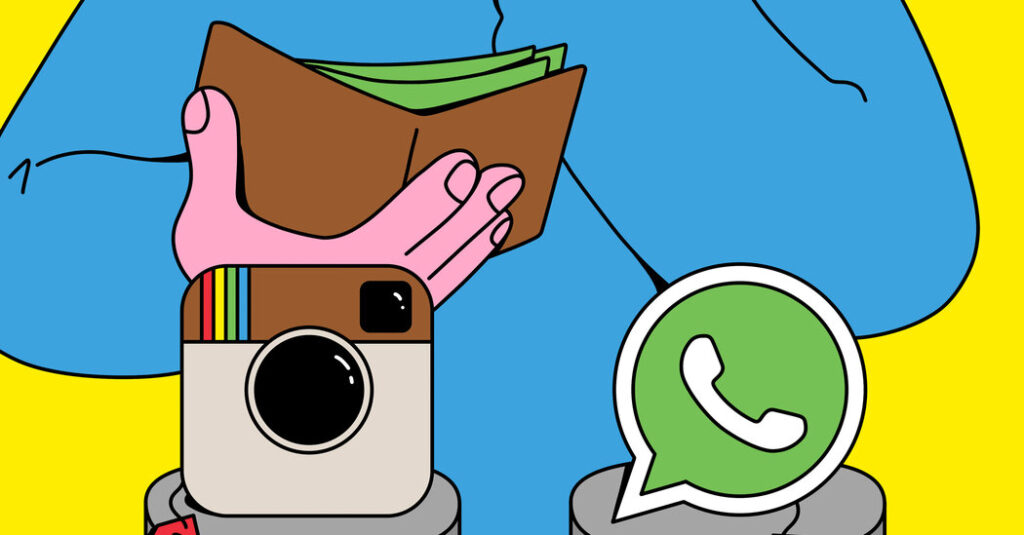In 2012, when Facebook’s chief executive, Mark Zuckerberg, cut a $1 billion check to buy the photo-sharing app Instagram, most people thought he had lost his marbles.
“A billion dollars of money?” joked Jon Stewart, then the host of “The Daily Show.” “For a thing that kind of ruins your pictures?”
Mr. Stewart called the decision “really lame.” His audience — and much of the rest of the world — agreed that Mr. Zuckerberg had overpaid for an app that highlighted a bunch of photo filters.
Two years later, Mr. Zuckerberg opened his wallet again when Facebook agreed to buy WhatsApp for $19 billion. Many Americans had never heard of the messaging app, which was popular internationally but not well known in the United States.
No one knew how these deals would turn out. But hindsight, it seems, is 20/20.
On Monday, the government argued in a landmark antitrust trial that both acquisitions — now considered among the greatest in Silicon Valley history — were the actions of a monopolist guarding his turf. Mr. Zuckerberg, in turn, was set to contend that were it not for these deals, his company — which has been renamed Meta — would just be an afterthought in the social media landscape.
But the case, which could bring about the breakup of one of tech’s most powerful companies, largely deals in hypotheticals. Neither the government nor Mr. Zuckerberg could have predicted how technology would progress since his $1 billion check for Instagram, or what would have happened if regulators had not approved the purchases. That makes Meta’s antitrust case one of the most slippery in a tech industry that has long been defined by unpredictability.
“It was a very, very different time in Silicon Valley,” said Margaret O’Mara, a tech historian at the University of Washington, about Facebook’s acquisitions. “There was a vibe of ‘Oh, wow, Facebook really is just a bunch of kids spending extravagantly!’”
I happened to have a front-row seat into Facebook’s deal-making at the time, especially with Instagram. As a reporter for Wired Magazine, I had an office next to Instagram’s headquarters in San Francisco. I frequented the kimchi burrito place across the street near South Park Commons — a slice of green in the city — and ate on a bench outside Instagram’s office.
Kevin Systrom, Instagram’s 6-foot-5 co-founder, was 28. He often walked laps around the wood-and-iron swing set in South Park Commons while taking calls or talking product ideas with employees. Jack Dorsey, a co-founder of Twitter who identified as more of an art kid than a techie, also hung out at the same South Park playground and mused to friends about ideas that eventually became his social media app.
This was still the era when social apps were dismissed as playthings, for posting latte art or telling people what you were having for breakfast. WhatsApp, which was growing quickly internationally, was a text-messaging app without a business model. And clones of these apps were plentiful, such as Color, Flickr and VSCO in photo sharing, and Kik, Skype and Viber in messaging.
Even Facebook faced questions then about whether it was a viable business. Two months after the Silicon Valley company announced that it was buying Instagram, it held one of the most disastrous tech initial public offerings since the late-1990s dot-com era.
By the time Mr. Systrom testified three months later to the California Department of Corporations — a condition of closing the deal with Facebook — shares of Facebook had fallen by nearly half from their I.P.O. price.
But in Silicon Valley, fortunes rise and fall quickly. Companies go from frivolous fancies to juggernauts in just a few years. And what may look like a shrewd business move by an executive one moment can be quickly ridiculed as a misstep the next. (Half of the aforementioned apps are dead or dying or were sold for parts long ago. My favorite kimchi burrito place is also no longer around.)
At the time, Mr. Systrom gave a positive spin on the Instagram deal as the future looked increasingly grim for Facebook.
“I’ve been taught throughout my life that there’s upside and downside in all public markets,” he said at the California Department of Corporations hearing in August 2012, which I attended on the sixth floor of the department in downtown San Francisco. “I still believe firmly in the long-term value of Facebook.”
He turned out to be right. Today, Instagram and WhatsApp are two of the most important parts of Meta’s business. Posts, videos and communications on the platforms regularly drive global conversations for sports, news, politics and culture. The apps have billions of users.
In some ways, the antitrust trial is about competing versions of what tech history could have been. What would have happened if, say, Mr. Zuckerberg had lost the bid for Instagram to Mr. Dorsey, who was also trying to buy the photo-sharing app for Twitter? What if WhatsApp had sold to Google, which was champing at the bit to add the messaging app to its own portfolio?
What if other competitors had created superior photo-sharing apps that could have thrived if Facebook hadn’t used Instagram to crush them? And what if Facebook had screwed up both deals, or could not keep up with competing apps and fell behind even after buying Instagram and WhatsApp?
These are unknowable and can be answered only by someone with a time machine. Each side is arguing its version of what would have occurred if Meta’s acquisitions had never been approved.
On the same “Daily Show” segment from 2012, Jessica Williams, the senior youth correspondent, said — tongue fully in cheek — that Facebook’s purchase of Instagram made perfect sense.
“Before Instagram, if I wanted my pictures to look like they were taken in the ’60s, I’d have to invent a time machine and travel back 50 years,” she said. “You know how much a time machine would cost to build?
“Easily a billion dollars.”
https://www.nytimes.com/2025/04/14/technology/mark-zuckerberg-facebook-instagram-whatsapp.html


